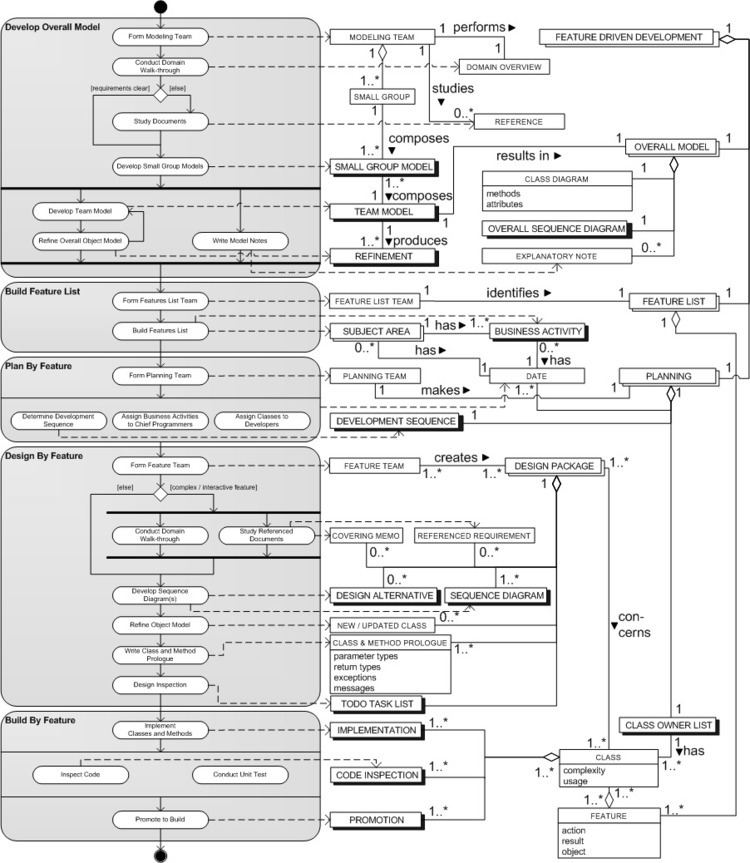 | ||
Feature-driven development (FDD) is an iterative and incremental software development process. It is one of a number of lightweight or Agile methods for developing software. FDD blends a number of industry-recognized best practices into a cohesive whole. These practices are all driven from a client-valued functionality (feature) perspective. Its main purpose is to deliver tangible, working software repeatedly in a timely manner.
Contents
History
FDD was initially devised by Jeff De Luca to meet the specific needs of a 15-month, 50-person software development project at a large Singapore bank in 1997. Jeff De Luca delivered a set of five processes that covered the development of an overall model and the listing, planning, design and building of features. The first process is heavily influenced by Peter Coad's approach to object modeling. The second process incorporates Peter Coad's ideas of using a feature list to manage functional requirements and development tasks. The other processes and the blending of the processes into a cohesive whole is a result of Jeff De Luca's experience. Since its successful use on the Singapore project, there have been several implementations of FDD.
The description of FDD was first introduced to the world in Chapter 6 of the book Java Modeling in Color with UML[1] by Peter Coad, Eric Lefebvre and Jeff De Luca in 1999. Later, in Stephen Palmer and Mac Felsing's book A Practical Guide to Feature-Driven Development[2] (published in 2002), a more general description of FDD was given, as decoupled from Java modeling.
The original and latest FDD processes can be found on Jeff De Luca´s website under the ´Article´ area. There is also a Community website available at which people can learn more about FDD, questions can be asked, and experiences and the processes themselves are discussed.
Overview
FDD is a model-driven short-iteration process that consists of five basic activities. For accurate state reporting and keeping track of the software development project, milestones that mark the progress made on each feature are defined. This section gives a high level overview of the activities. In the figure on the right, the meta-process model for these activities is displayed. During the first two sequential activities, an overall model shape is established. The final three activities are iterated for each feature. For more detailed information about the individual sub-activities have a look at Table 2 (derived from the process description in the ´Article´ section of Jeff De Luca´s website). The concepts involved in these activities are explained in Table 3.
Develop overall model
The FDD project starts with a high-level walkthrough of the scope of the system and its context. Next, detailed domain models are created for each modeling area by small groups and presented for peer review. One of the proposed models, or a combination of them, is selected to become the model for each domain area. Domain area models are progressively merged into an overall model.
Build feature list
The knowledge gathered during the initial modeling is used to identify a list of features, by functionally decomposing the domain into subject areas. Subject areas each contain business activities, and the steps within each business activity form the basis for a categorized feature list. Features in this respect are small pieces of client-valued functions expressed in the form "<action> <result> <object>", for example: 'Calculate the total of a sale' or 'Validate the password of a user'. Features should not take more than two weeks to complete, else they should be broken down into smaller pieces.
Plan by feature
After the feature list is completed, the next step is to produce the development plan; assigning ownership of features (or feature sets) as classes to programmers.
Design by feature
A design package is produced for each feature. A chief programmer selects a small group of features that are to be developed within two weeks. Together with the corresponding class owners, the chief programmer works out detailed sequence diagrams for each feature and refines the overall model. Next, the class and method prologues are written and finally a design inspection is held.
Build by feature
After a successful design inspection as per feature activity to produce a completed client-valued function (feature) is planned. The class owners, each develop code for their classes. After unit testing and successful code inspection, the completed feature is promoted to the main build.
Milestones
Since features are small, completing a feature is a relatively small task. For accurate state reporting and keeping track of the software development project it is however important to mark the progress made on each feature. FDD therefore defines six milestones per feature that are to be completed sequentially. The first three milestones are completed during the Design By Feature activity, the last three are completed during the Build By Feature activity. To help with tracking progress, a percentage complete is assigned to each milestone. In the table below the milestones (and their completion percentage) are shown. At the point that coding begins a feature is already 44% complete (Domain Walkthrough 1%, Design 40% and Design Inspection 3% = 44%).
Best practices
Feature-driven development is built on a core set of software engineering best practices, all aimed at a client-valued feature perspective.
Metamodel (MetaModeling)
Metamodeling helps visualizing both the processes and the data of a method, such that methods can be compared and method fragments in the method engineering process can easily be reused. The advantage of the technique is that it is clear, compact, and consistent with UML standards.
The left side of the metadata model, depicted on the right, shows the five basic activities involved in a software development project using FDD. The activities all contain sub-activities that correspond to the sub-activities in the FDD process description on Jeff De Luca´s website. The right side of the model shows the concepts involved. These concepts originate from the activities depicted in the left side of the diagram. A definition of the concepts is given in Table 3.
